Bible Class 07
Chris Knepp
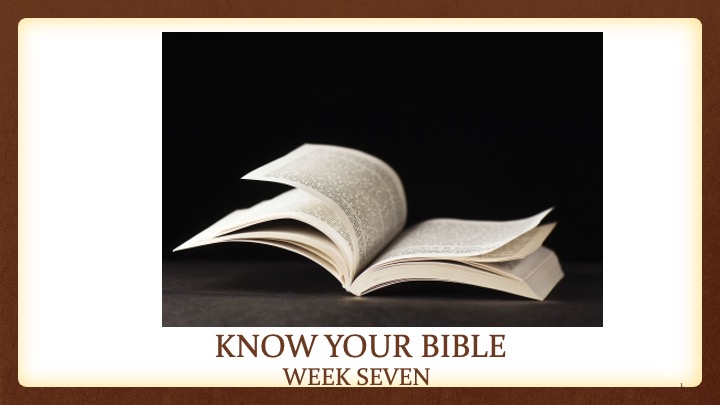
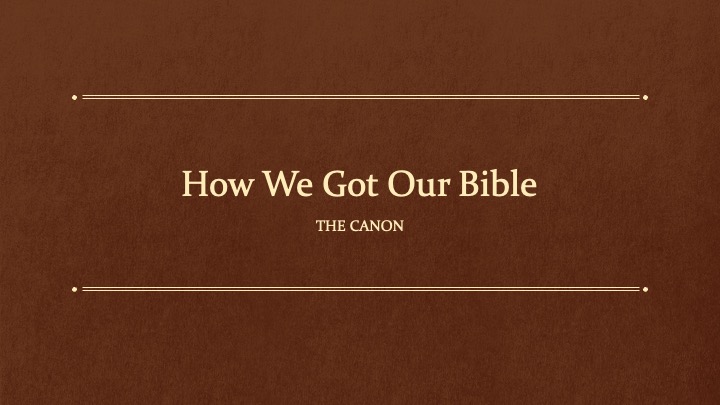
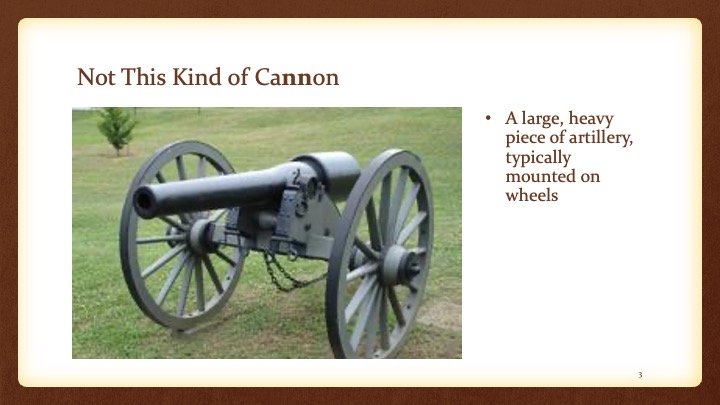
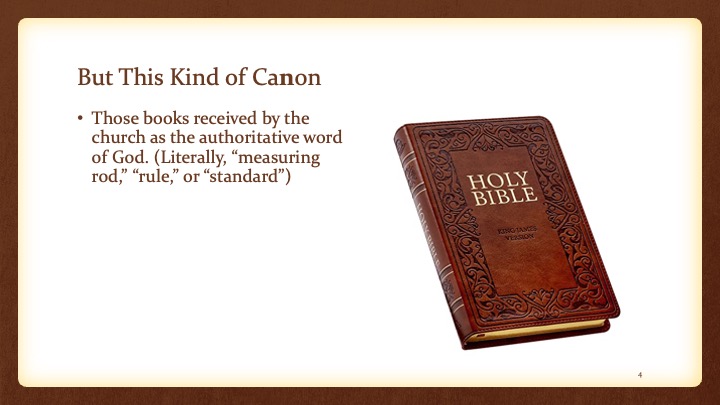
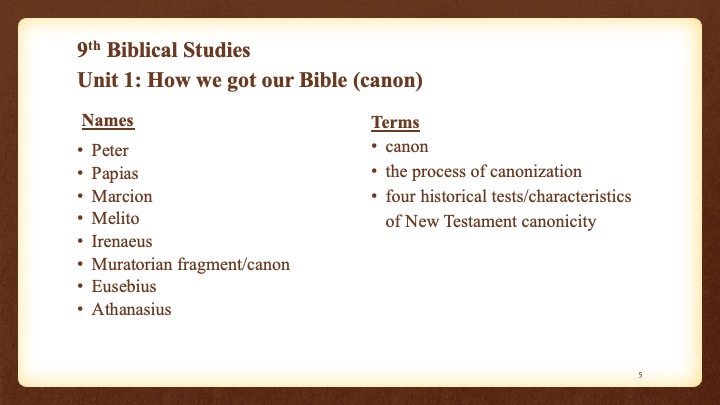
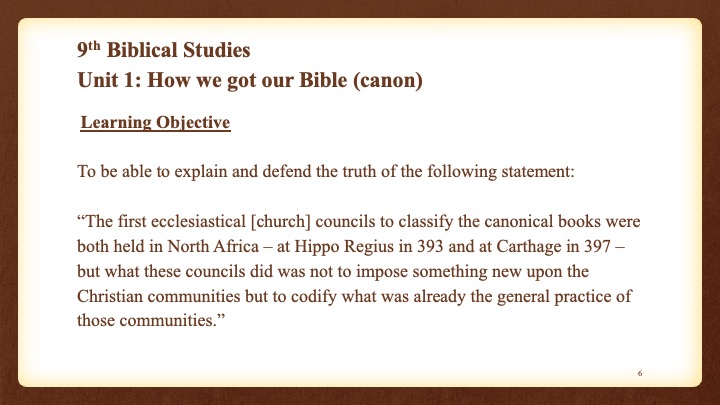
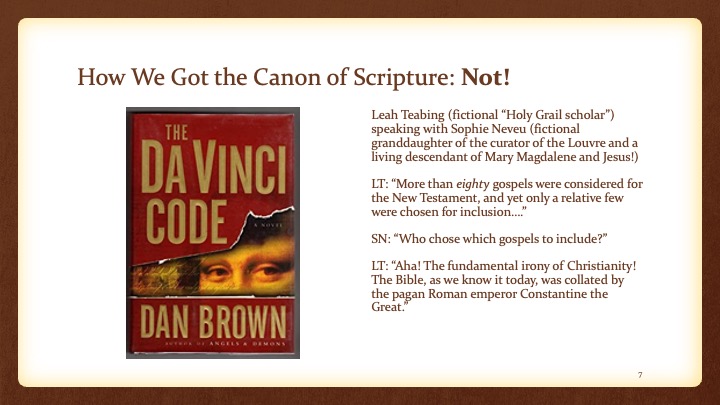
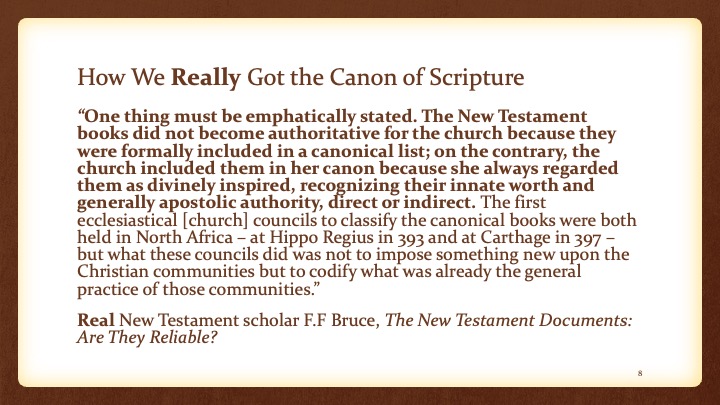
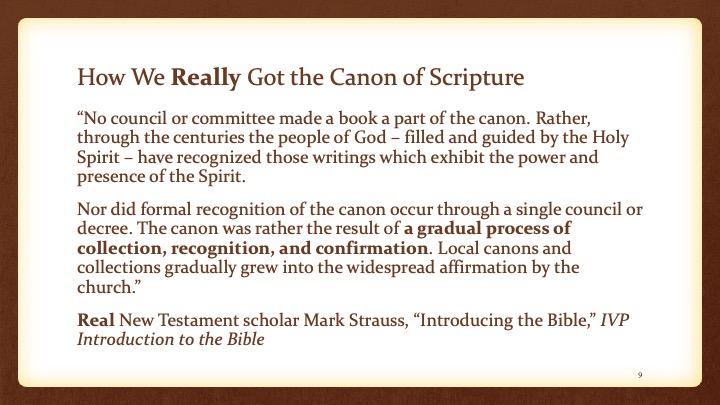
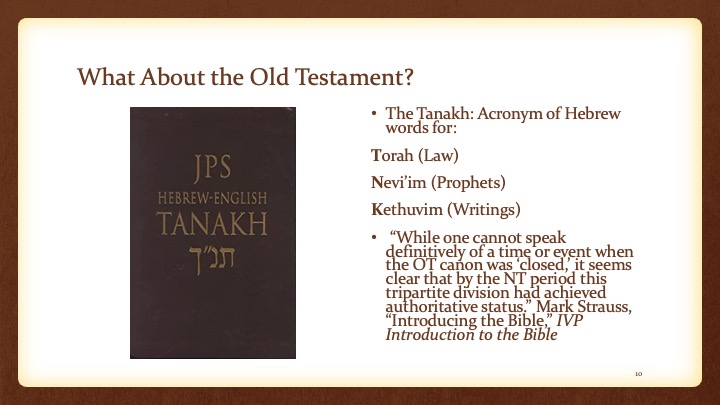
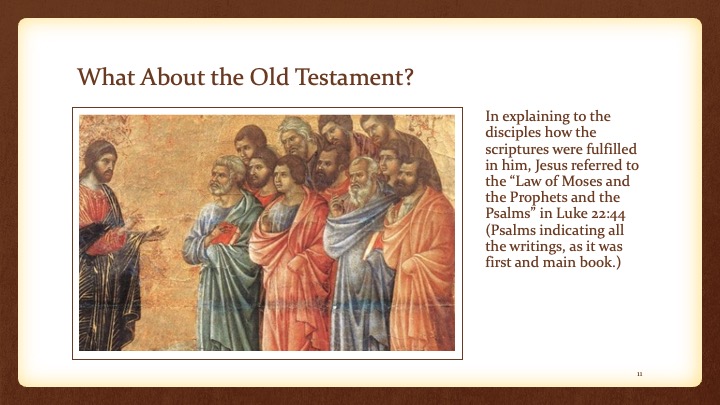
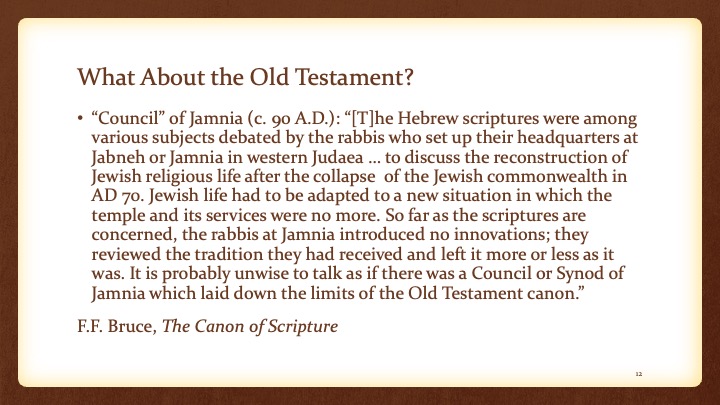
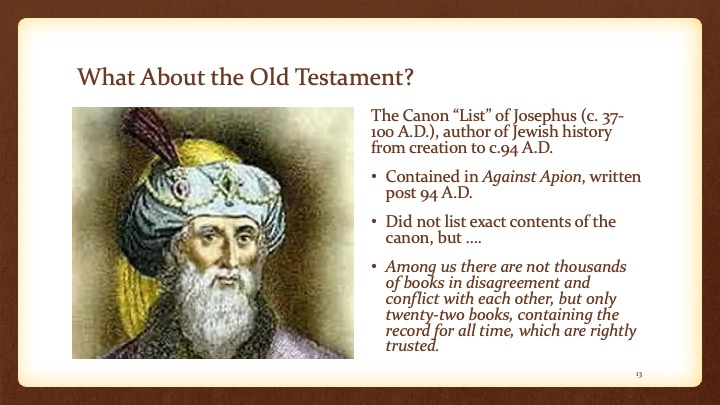
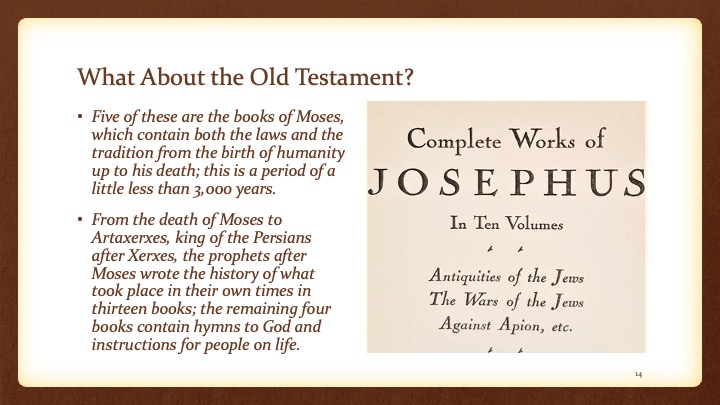
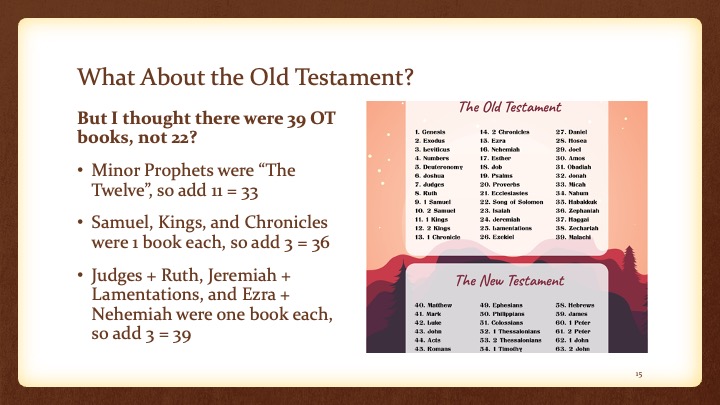
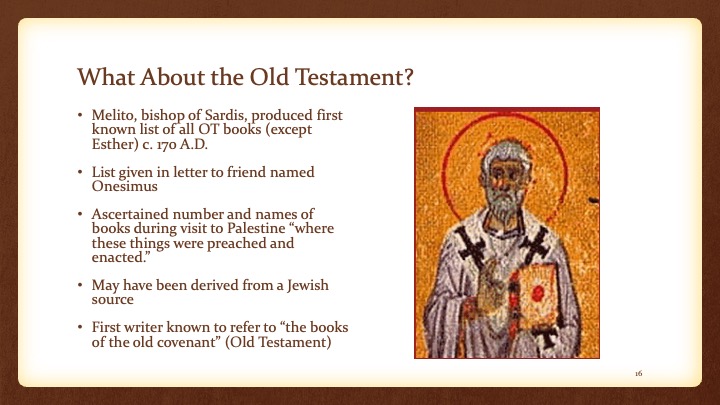
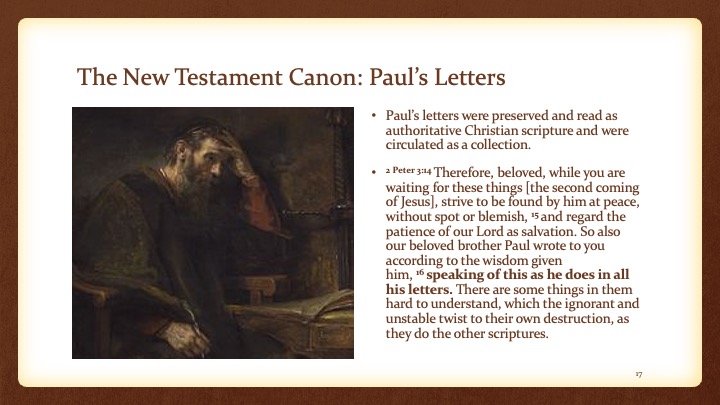
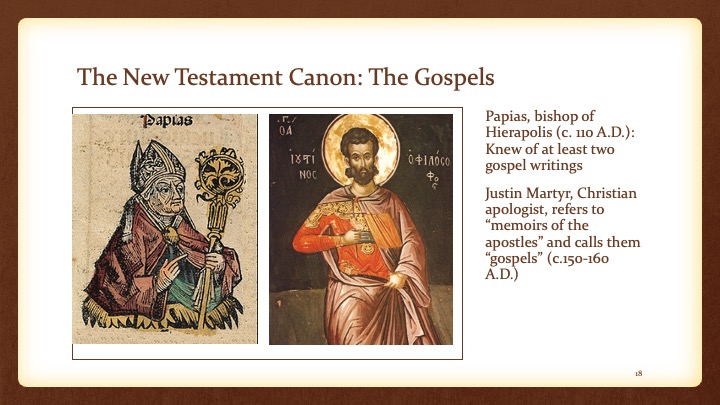
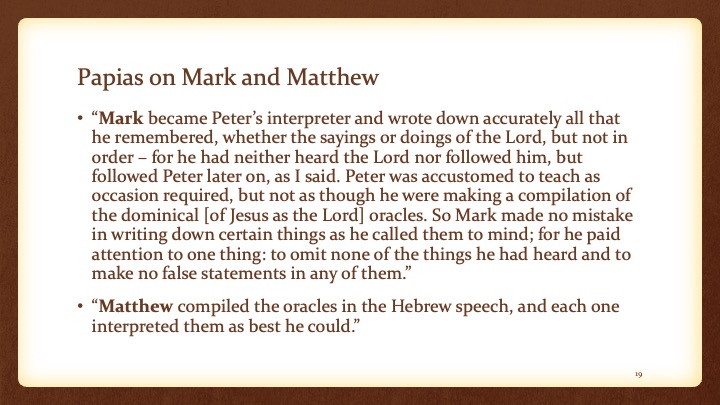
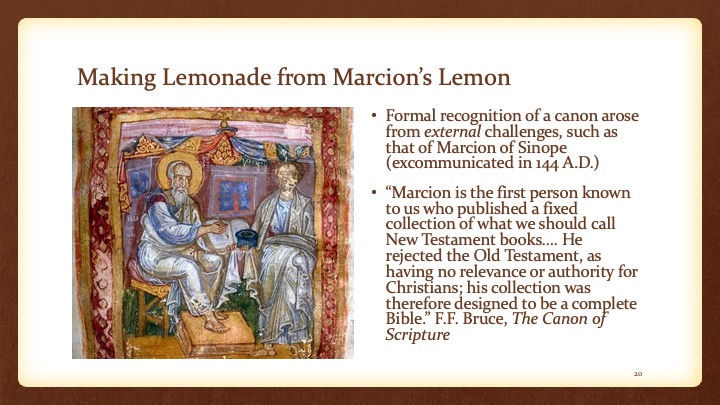
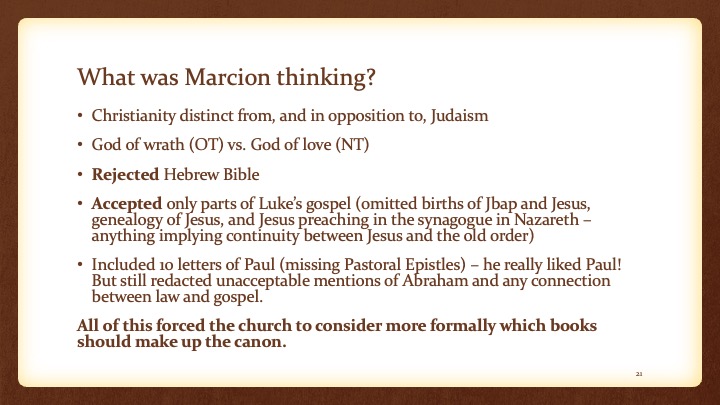
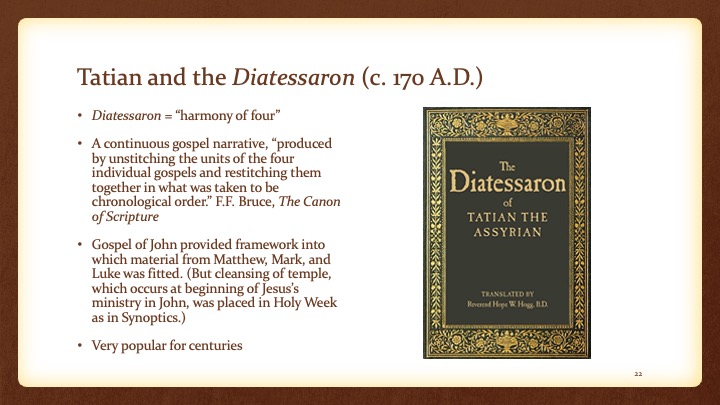
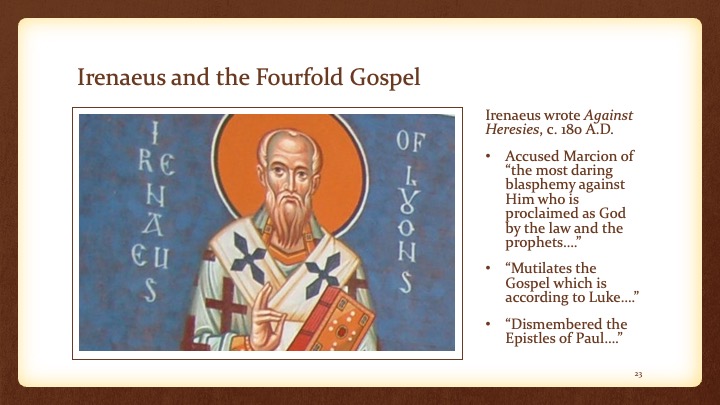
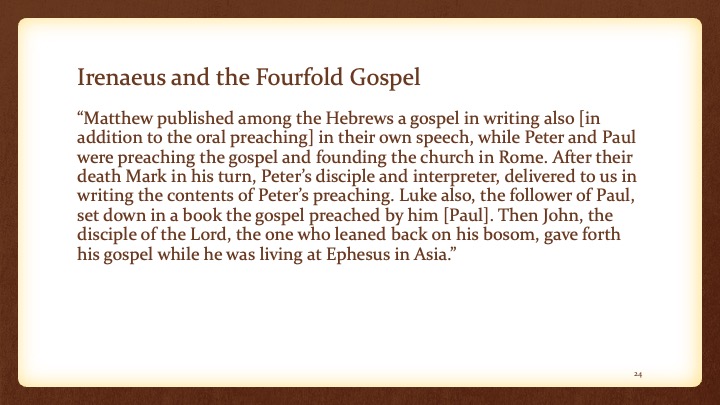
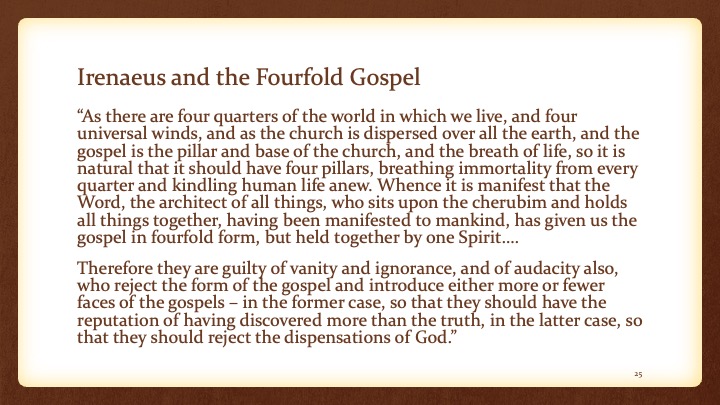
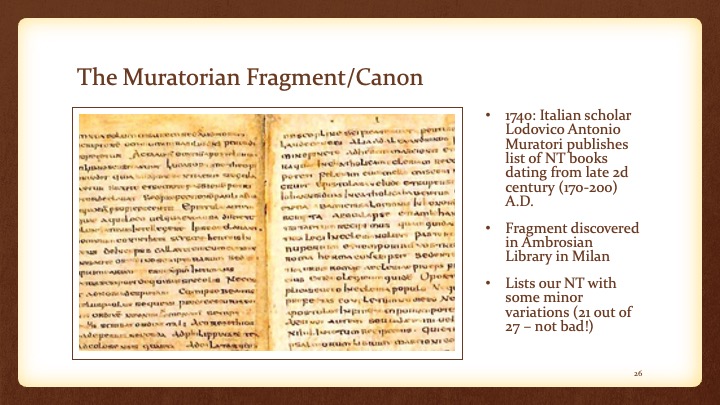
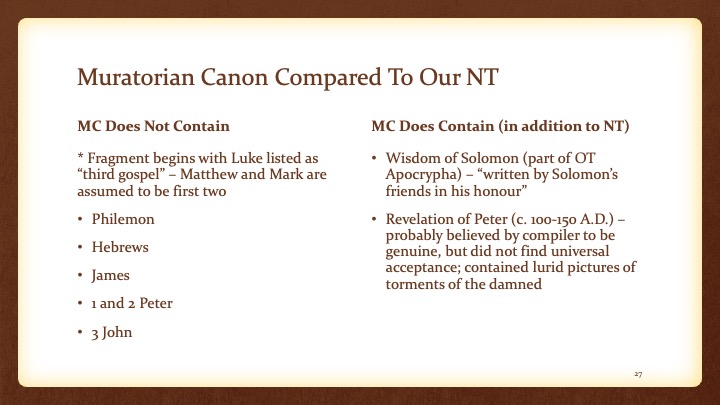
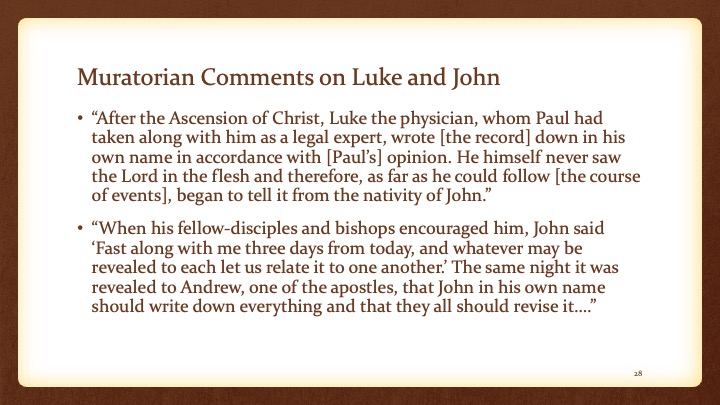
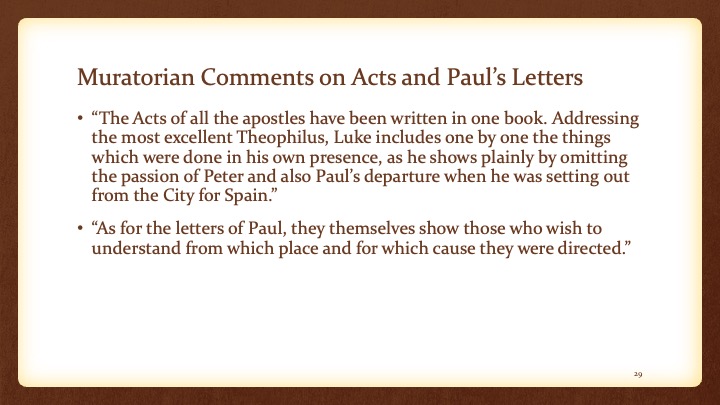
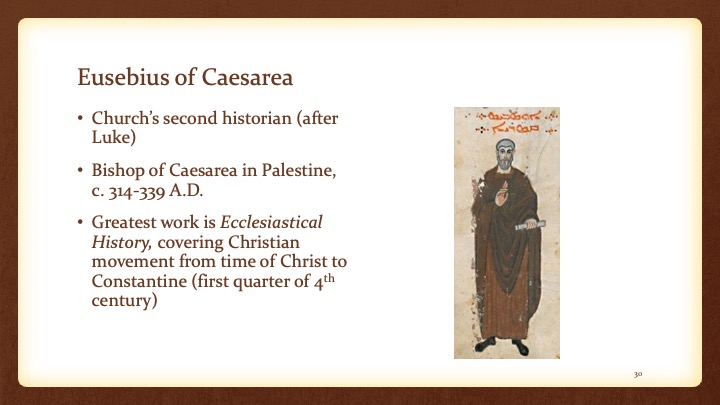
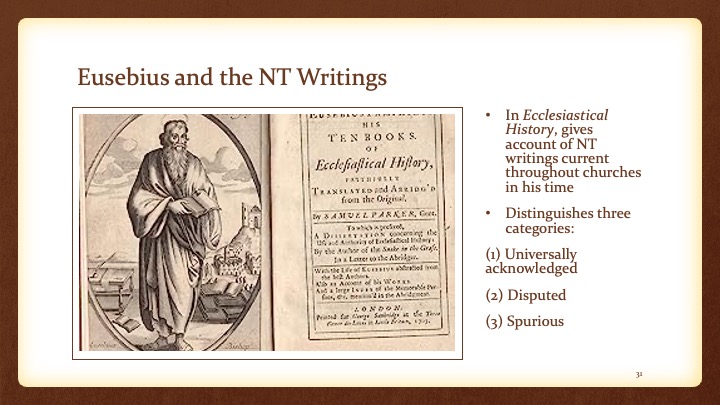
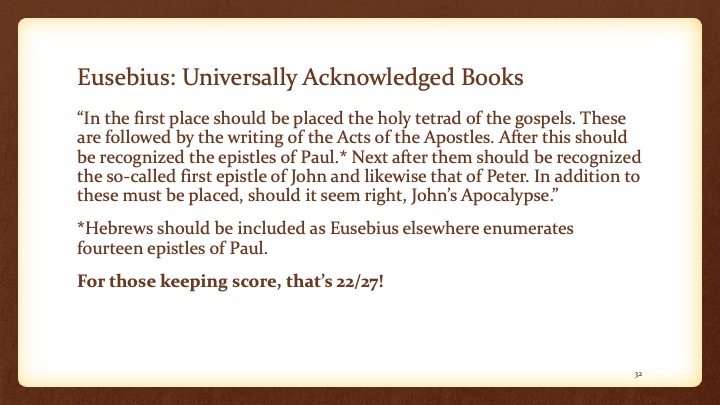
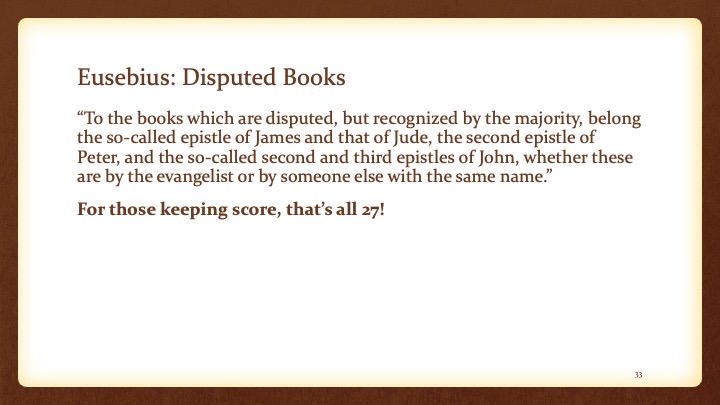
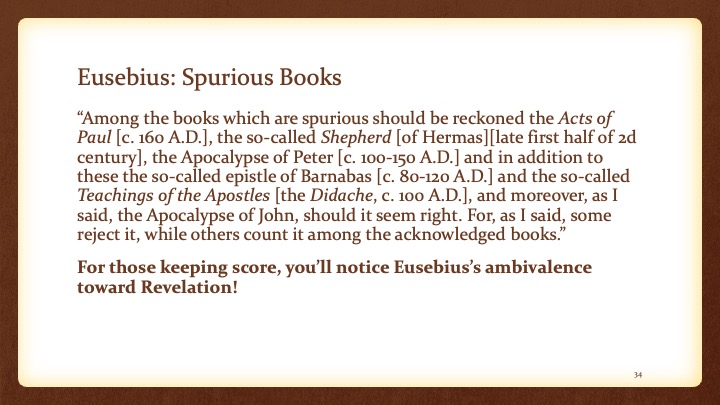
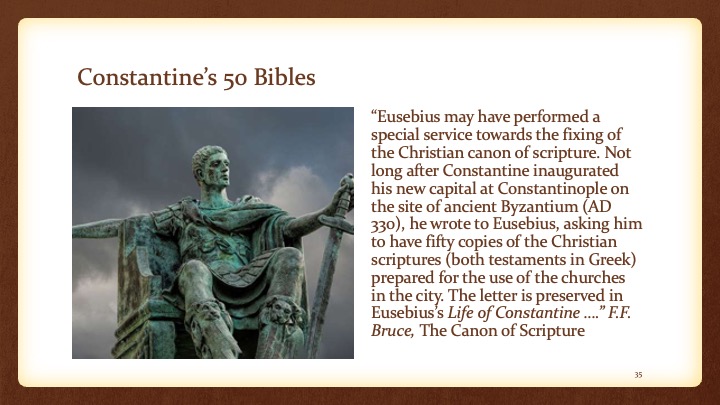
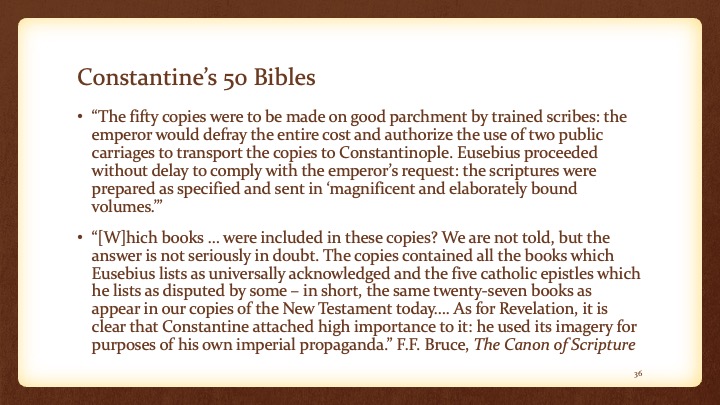
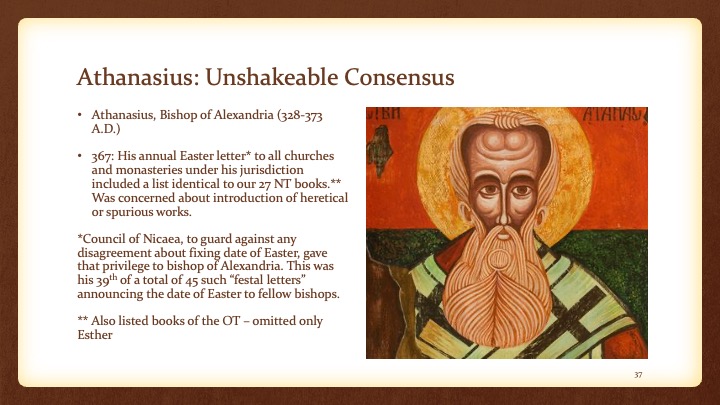
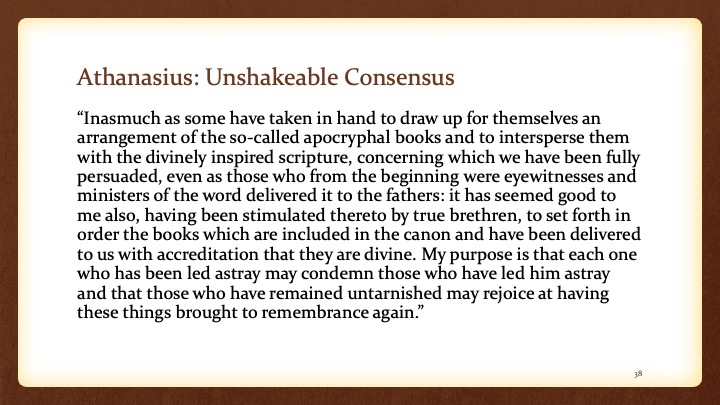
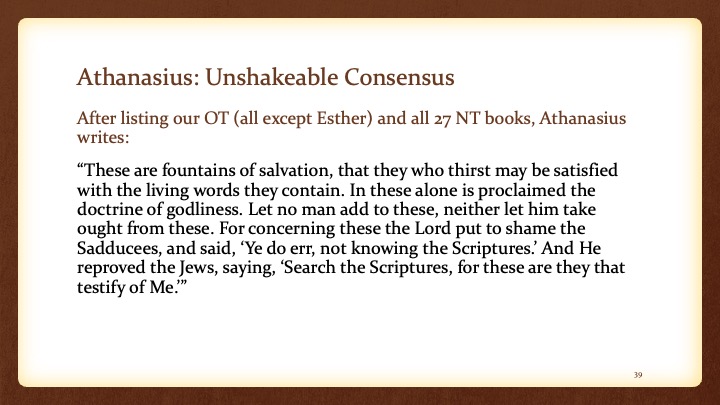
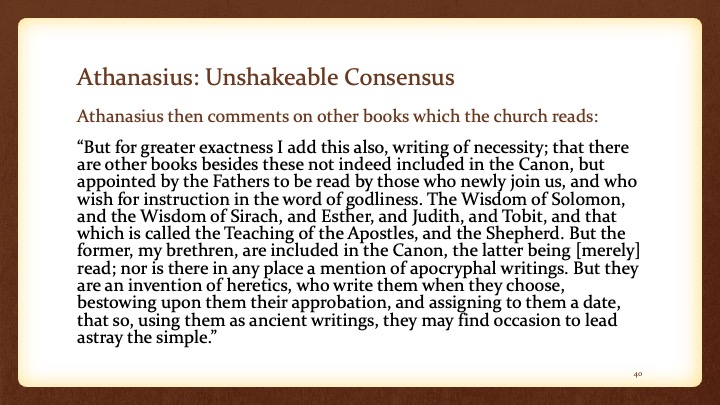
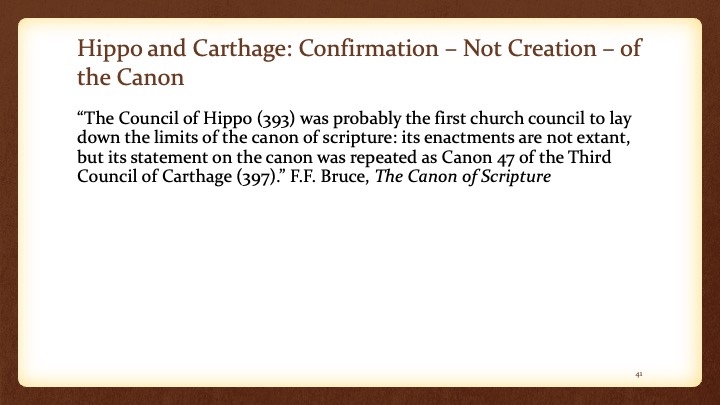
Bible Class 07
Links
< Home Page > < Top of Page >
Know Your Bible Week 7 Text
KNOW YOUR BIBLE
WEEK SEVEN
How We Got Our Bible
Canon
Not This Kind of Cannon
• A large, heavy piece of artillery, typically mounted on wheels
But This Kind of Canon
• Those books received by the church as the authoritative word of God. (Literally, “measuring rod,” “rule,” or “standard”)
9th Biblical Studies
Unit 1: How we got our Bible (canon)
Names (the players)
• Peter
• Papias
• Marcion
• Melito
• Irenaeus
• Muratorian fragment/canon
• Eusebius
• Athanasius
Terms
• canon
• the process of canonization
• four historical tests/characteristics of New Testament canonicity
Learning Objective
• To be able to explain and defend the truth of the following statement:
• “The first ecclesiastical [church] councils to classify the canonical books were both held in North Africa – at Hippo Regius in 393 and at Carthage in 397 – but what these councils did was not to impose something new upon the Christian communities but to codify what was already the general practice of those communities.”
How We Got the Canon of Scripture: Not! Not as in the movie The Da Vinci Code
Leah Teabing (fictional “Holy Grail scholar”) speaking with Sophie Neveu (fictional granddaughter of the curator of the Louvre and a living descendant of Mary Magdalene and Jesus!)
LT: “More than eighty gospels were considered for the New Testament, and yet only a relative few were chosen for inclusion….”
SN: “Who chose which gospels to include?”
LT: “Aha! The fundamental irony of Christianity! The Bible, as we know it today, was collated by the pagan Roman emperor Constantine the Great.”
Wrong! How We Really Got the Canon of Scripture
“One thing must be emphatically stated. The New Testament books did not become authoritative for the church because they were formally included in a canonical list; on the contrary, the church included them in her canon because she always regarded them as divinely inspired, recognizing their innate worth and generally apostolic authority, direct or indirect. The first ecclesiastical [church] councils to classify the canonical books were both held in North Africa – at Hippo Regius in 393 and at Carthage in 397 – but what these councils did was not to impose something new upon the Christian communities but to codify what was already the general practice of those communities.”
Real New Testament scholar F.F Bruce, The New Testament Documents: Are They Reliable?
“No council or committee made a book a part of the canon. Rather, through the centuries the people of God – filled and guided by the Holy Spirit – have recognized those writings which exhibit the power and presence of the Spirit.
Nor did formal recognition of the canon occur through a single council or decree. The canon was rather the result of a gradual process of collection, recognition, and confirmation. Local canons and collections gradually grew into the widespread affirmation by the church.”
Real New Testament scholar Mark Strauss, “Introducing the Bible,” IVP Introduction to the Bible
What About the Old Testament?
• The Tanakh: Acronym of Hebrew words for:
Torah (Law)
Nevi’im (Prophets)
Kethuvim (Writings)
• “While one cannot speak definitively of a time or event when the OT canon was ‘closed,’ it seems clear that by the NT period this tripartite division had achieved authoritative status.” Mark Strauss, “Introducing the Bible,” IVP Introduction to the Bible
• In explaining to the disciples how the scriptures were fulfilled in him, Jesus referred to the “Law of Moses and the Prophets and the Psalms” in Luke 22:44 (Psalms indicating all the writings, as it was first and main book.)
• “Council” of Jamnia (c. 90 A.D.): “[T]he Hebrew scriptures were among various subjects debated by the rabbis who set up their headquarters at Jabneh or Jamnia in western Judaea … to discuss the reconstruction of Jewish religious life after the collapse of the Jewish commonwealth in AD 70. Jewish life had to be adapted to a new situation in which the temple and its services were no more. So far as the scriptures are concerned, the rabbis at Jamnia introduced no innovations; they reviewed the tradition they had received and left it more or less as it was. It is probably unwise to talk as if there was a Council or Synod of Jamnia which laid down the limits of the Old Testament canon.”
F.F. Bruce, The Canon of Scripture
The Canon “List” of Josephus (c. 37-100 A.D.), author of Jewish history from creation to c.94 A.D.
• Contained in "Against Apion", written post 94 A.D.
• Did not list exact contents of the canon, but ….
• Among us there are not thousands of books in disagreement and conflict with each other, but only twenty-two books, containing the record for all time, which are rightly trusted.
• Five of these are the books of Moses, which contain both the laws and the tradition from the birth of humanity up to his death; this is a period of a little less than 3,000 years.
• From the death of Moses to Artaxerxes, king of the Persians after Xerxes, the prophets after Moses wrote the history of what took place in their own times in thirteen books; the remaining four books contain hymns to God and instructions for people on life.
Wait! But I thought there were 39 OT books, not 22?
• Minor Prophets were “The Twelve”, so add 11 = 33
• Samuel, Kings, and Chronicles were 1 book each, so add 3 = 36
• Judges + Ruth, Jeremiah + Lamentations, and Ezra + Nehemiah were one book each, so add 3 = 39
• Melito, bishop of Sardis, produced first known list of all OT books (except Esther) c. 170 A.D.
• List given in letter to friend named Onesimus
• Ascertained number and names of books during visit to Palestine “where these things were preached and enacted.”
• May have been derived from a Jewish source
• First writer known to refer to “the books of the old covenant” (Old Testament)
The New Testament Canon: Paul’s Letters
• Paul’s letters were preserved and read as authoritative Christian scripture and were circulated as a collection.
• 2 Peter 3:14 Therefore, beloved, while you are waiting for these things [the second coming of Jesus], strive to be found by him at peace, without spot or blemish, 15 and regard the patience of our Lord as salvation. So also our beloved brother Paul wrote to you according to the wisdom given him, 16 speaking of this as he does in all his letters. There are some things in them hard to understand, which the ignorant and unstable twist to their own destruction, as they do the other scriptures.
The New Testament Canon: The Gospels
Papias, bishop of Hierapolis (c. 110 A.D.): Knew of at least two gospel writings
Justin Martyr, Christian apologist, refers to “memoirs of the apostles” and calls them “gospels” (c.150-160 A.D.)
Papias on Mark and Matthew
• “Mark became Peter’s interpreter and wrote down accurately all that he remembered, whether the sayings or doings of the Lord, but not in order – for he had neither heard the Lord nor followed him, but followed Peter later on, as I said. Peter was accustomed to teach as occasion required, but not as though he were making a compilation of the dominical [of Jesus as the Lord] oracles. So Mark made no mistake in writing down certain things as he called them to mind; for he paid attention to one thing: to omit none of the things he had heard and to make no false statements in any of them.”
• “Matthew compiled the oracles in the Hebrew speech, and each one interpreted them as best he could.”
Making Lemonade from Marcion’s Lemon
• Formal recognition of a canon arose from external challenges, such as that of Marcion of Sinope (excommunicated in 144 A.D.)
• “Marcion is the first person known to us who published a fixed collection of what we should call New Testament books…. He rejected the Old Testament, as having no relevance or authority for Christians; his collection was therefore designed to be a complete Bible.” F.F. Bruce, The Canon of Scripture
What was Marcion thinking?
• Christianity distinct from, and in opposition to, Judaism
• God of wrath (OT) vs. God of love (NT)
• Rejected Hebrew Bible
• Accepted only parts of Luke’s gospel (omitted births of Jbap and Jesus, genealogy of Jesus, and Jesus preaching in the synagogue in Nazareth – anything implying continuity between Jesus and the old order)
• Included 10 letters of Paul (missing Pastoral Epistles) – he really liked Paul! But still redacted unacceptable mentions of Abraham and any connection between law and gospel.
All of this forced the church to consider more formally which books should make up the canon.
Tatian and the Diatessaron (c. 170 A.D.)
• Diatessaron = “harmony of four”
• A continuous gospel narrative, “produced by unstitching the units of the four individual gospels and restitching them together in what was taken to be chronological order.” F.F. Bruce, The Canon of Scripture
• Gospel of John provided framework into which material from Matthew, Mark, and Luke was fitted. (But cleansing of temple, which occurs at beginning of Jesus’s ministry in John, was placed in Holy Week as in Synoptics.)
• Very popular for centuries
Irenaeus and the Fourfold Gospel
Irenaeus wrote Against Heresies, c. 180 A.D.
• Accused Marcion of “the most daring blasphemy against Him who is proclaimed as God by the law and the prophets….”
• “Mutilates the Gospel which is according to Luke….”
• “Dismembered the Epistles of Paul….”
• “Matthew published among the Hebrews a gospel in writing also [in addition to the oral preaching] in their own speech, while Peter and Paul were preaching the gospel and founding the church in Rome. After their death Mark in his turn, Peter’s disciple and interpreter, delivered to us in writing the contents of Peter’s preaching. Luke also, the follower of Paul, set down in a book the gospel preached by him [Paul]. Then John, the disciple of the Lord, the one who leaned back on his bosom, gave forth his gospel while he was living at Ephesus in Asia.”
• “As there are four quarters of the world in which we live, and four universal winds, and as the church is dispersed over all the earth, and the gospel is the pillar and base of the church, and the breath of life, so it is natural that it should have four pillars, breathing immortality from every quarter and kindling human life anew. Whence it is manifest that the Word, the architect of all things, who sits upon the cherubim and holds all things together, having been manifested to mankind, has given us the gospel in fourfold form, but held together by one Spirit….
• Therefore they are guilty of vanity and ignorance, and of audacity also, who reject the form of the gospel and introduce either more or fewer faces of the gospels – in the former case, so that they should have the reputation of having discovered more than the truth, in the latter case, so that they should reject the dispensations of God.”
The Muratorian Fragment/Canon
• 1740: Italian scholar Lodovico Antonio Muratori publishes list of NT books dating from late 2d century (170-200) A.D.
• Fragment discovered in Ambrosian Library in Milan
• Lists our NT with some minor variations (21 out of 27 – not bad!)
Muratorian Canon Compared To Our NT
MC Does Not Contain
* Fragment begins with Luke listed as “third gospel” – Matthew and Mark are assumed to be first two
• Philemon
• Hebrews
• James
• 1 and 2 Peter
• 3 John
• MC Does Contain (in addition to NT)
• Wisdom of Solomon (part of OT Apocrypha) – “written by Solomon’s friends in his honour”
• Revelation of Peter (c. 100-150 A.D.) – probably believed by compiler to be genuine, but did not find universal acceptance; contained lurid pictures of torments of the damned
Muratorian Comments on Luke and John
• “After the Ascension of Christ, Luke the physician, whom Paul had taken along with him as a legal expert, wrote [the record] down in his own name in accordance with [Paul’s] opinion. He himself never saw the Lord in the flesh and therefore, as far as he could follow [the course of events], began to tell it from the nativity of John.”
• “When his fellow-disciples and bishops encouraged him, John said ‘Fast along with me three days from today, and whatever may be revealed to each let us relate it to one another.’ The same night it was revealed to Andrew, one of the apostles, that John in his own name should write down everything and that they all should revise it….”
Muratorian Comments on Acts and Paul’s Letters
• “The Acts of all the apostles have been written in one book. Addressing the most excellent Theophilus, Luke includes one by one the things which were done in his own presence, as he shows plainly by omitting the passion of Peter and also Paul’s departure when he was setting out from the City for Spain.”
• “As for the letters of Paul, they themselves show those who wish to understand from which place and for which cause they were directed.”
Eusebius of Caesarea
• Church’s second historian (after Luke)
• Bishop of Caesarea in Palestine, c. 314-339 A.D.
• Greatest work is Ecclesiastical History, covering Christian movement from time of Christ to Constantine (first quarter of 4th century)
Eusebius and the NT Writings
• In Ecclesiastical History, gives account of NT writings current throughout churches in his time
• Distinguishes three categories:
(1) Universally acknowledged
(2) Disputed
(3) Spurious
Eusebius: Universally Acknowledged Books
“In the first place should be placed the holy tetrad of the gospels. These are followed by the writing of the Acts of the Apostles. After this should be recognized the epistles of Paul.* Next after them should be recognized the so-called first epistle of John and likewise that of Peter. In addition to these must be placed, should it seem right, John’s Apocalypse.”
*Hebrews should be included as Eusebius elsewhere enumerates fourteen epistles of Paul.
For those keeping score, that’s 22/27!
Eusebius: Disputed Books
“To the books which are disputed, but recognized by the majority, belong the so-called epistle of James and that of Jude, the second epistle of Peter, and the so-called second and third epistles of John, whether these are by the evangelist or by someone else with the same name.”
For those keeping score, that’s all 27!
Eusebius: Spurious Books
“Among the books which are spurious should be reckoned the Acts of Paul [c. 160 A.D.], the so-called Shepherd [of Hermas][late first half of 2d century], the Apocalypse of Peter [c. 100-150 A.D.] and in addition to these the so-called epistle of Barnabas [c. 80-120 A.D.] and the so-called Teachings of the Apostles [the Didache, c. 100 A.D.], and moreover, as I said, the Apocalypse of John, should it seem right. For, as I said, some reject it, while others count it among the acknowledged books.”
For those keeping score, you’ll notice Eusebius’s ambivalence toward Revelation!
Constantine’s 50 Bibles
“Eusebius may have performed a special service towards the fixing of the Christian canon of scripture. Not long after Constantine inaugurated his new capital at Constantinople on the site of ancient Byzantium (AD 330), he wrote to Eusebius, asking him to have fifty copies of the Christian scriptures (both testaments in Greek) prepared for the use of the churches in the city. The letter is preserved in Eusebius’s Life of Constantine ….” F.F. Bruce, The Canon of Scripture
• “The fifty copies were to be made on good parchment by trained scribes: the emperor would defray the entire cost and authorize the use of two public carriages to transport the copies to Constantinople. Eusebius proceeded without delay to comply with the emperor’s request: the scriptures were prepared as specified and sent in ‘magnificent and elaborately bound volumes.’”
• “[W]hich books … were included in these copies? We are not told, but the answer is not seriously in doubt. The copies contained all the books which Eusebius lists as universally acknowledged and the five catholic epistles which he lists as disputed by some – in short, the same twenty-seven books as appear in our copies of the New Testament today…. As for Revelation, it is clear that Constantine attached high importance to it: he used its imagery for purposes of his own imperial propaganda.” F.F. Bruce, The Canon of Scripture
Athanasius: Unshakeable Consensus
• Athanasius, Bishop of Alexandria (328-373 A.D.)
• 367: His annual Easter letter* to all churches and monasteries under his jurisdiction included a list identical to our 27 NT books.** Was concerned about introduction of heretical or spurious works.
*Council of Nicaea, to guard against any disagreement about fixing date of Easter, gave that privilege to bishop of Alexandria. This was his 39th of a total of 45 such “festal letters” announcing the date of Easter to fellow bishops.
** Also listed books of the OT – omitted only Esther
“Inasmuch as some have taken in hand to draw up for themselves an arrangement of the so-called apocryphal books and to intersperse them with the divinely inspired scripture, concerning which we have been fully persuaded, even as those who from the beginning were eyewitnesses and ministers of the word delivered it to the fathers: it has seemed good to me also, having been stimulated thereto by true brethren, to set forth in order the books which are included in the canon and have been delivered to us with accreditation that they are divine. My purpose is that each one who has been led astray may condemn those who have led him astray and that those who have remained untarnished may rejoice at having these things brought to remembrance again.”
After listing our OT (all except Esther) and all 27 NT books, Athanasius writes:
“These are fountains of salvation, that they who thirst may be satisfied with the living words they contain. In these alone is proclaimed the doctrine of godliness. Let no man add to these, neither let him take ought from these. For concerning these the Lord put to shame the Sadducees, and said, ‘Ye do err, not knowing the Scriptures.’ And He reproved the Jews, saying, ‘Search the Scriptures, for these are they that testify of Me.’”
Athanasius then comments on other books which the church reads:
“But for greater exactness I add this also, writing of necessity; that there are other books besides these not indeed included in the Canon, but appointed by the Fathers to be read by those who newly join us, and who wish for instruction in the word of godliness. The Wisdom of Solomon, and the Wisdom of Sirach, and Esther, and Judith, and Tobit, and that which is called the Teaching of the Apostles, and the Shepherd. But the former, my brethren, are included in the Canon, the latter being [merely] read; nor is there in any place a mention of apocryphal writings. But they are an invention of heretics, who write them when they choose, bestowing upon them their approbation, and assigning to them a date, that so, using them as ancient writings, they may find occasion to lead astray the simple.”
Hippo and Carthage: Confirmation – Not Creation – of the Canon
“The Council of Hippo (393) was probably the first church council to lay down the limits of the canon of scripture: its enactments are not extant, but its statement on the canon was repeated as Canon 47 of the Third Council of Carthage (397).” F.F. Bruce, The Canon of Scripture